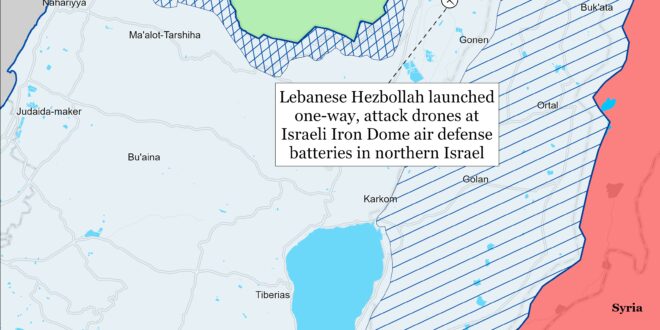Key Takeaways:
- Iraq: The United States and the Iraqi federal government will soon begin negotiations on Iraq’s current security arrangement with US-led coalition forces, which could involve US forces withdrawing from Iraq. Iranian-backed Iraqi actors praised the US and Iraqi decision to begin negotiations about the status of US-led coalition forces in Iraq.
- Yemen: Houthi Supreme Leader Abdulmalik al Houthi falsely claimed that Houthi attacks on maritime traffic in the Red Sea have not significantly impacted maritime trade. Abdulmalik separately reiterated the false Houthi narrative that the anti-shipping attacks have only targeted Israel-linked vessels and further claimed that the Houthis have allowed almost 5,000 non-Israel-linked vessels to freely operate in the Red Sea.
- Northern Gaza Strip: Israeli forces continued to engage Palestinian fighters throughout the northern part of the strip. CTP-ISW previously assessed that Hamas and other Palestinian militias are reinfiltrating areas that Israeli forces previously cleared.
- Central Gaza Strip: Palestinian Islamic Jihad and the Popular Front for the Liberation of Palestine conducted a combined attack targeting an Israeli supply line. The operation marks the third claimed indirect fire attack targeting Israeli supply lines in recent days.
- Southern Gaza Strip: Israeli forces continued conducting clearing operations in Khan Younis. Palestinian fighters continued conducting a deliberate defense against Israeli clearing operations in western and southern Khan Younis.
- Political Negotiations: US Central Intelligence Agency Director Bill Burns will meet with the Qatari prime minister and the Egyptian and Israeli intelligence chiefs in the coming days to broker a deal for the release of hostages and a pause in fighting in the Gaza Strip.
- West Bank: Israeli forces clashed with Palestinian fighter four times in the northern West Bank, primarily around Jenin and Tubas.
- Southern Lebanon and Golan Heights: Iranian-backed militias, including Lebanese Hezbollah, conducted four attacks from southern Lebanon into northern Israel.
- Iran: The Wall Street Journal reported that the United States secretly warned Iran that the Islamic State was preparing to conduct the January 3 terrorist attack in Kerman.
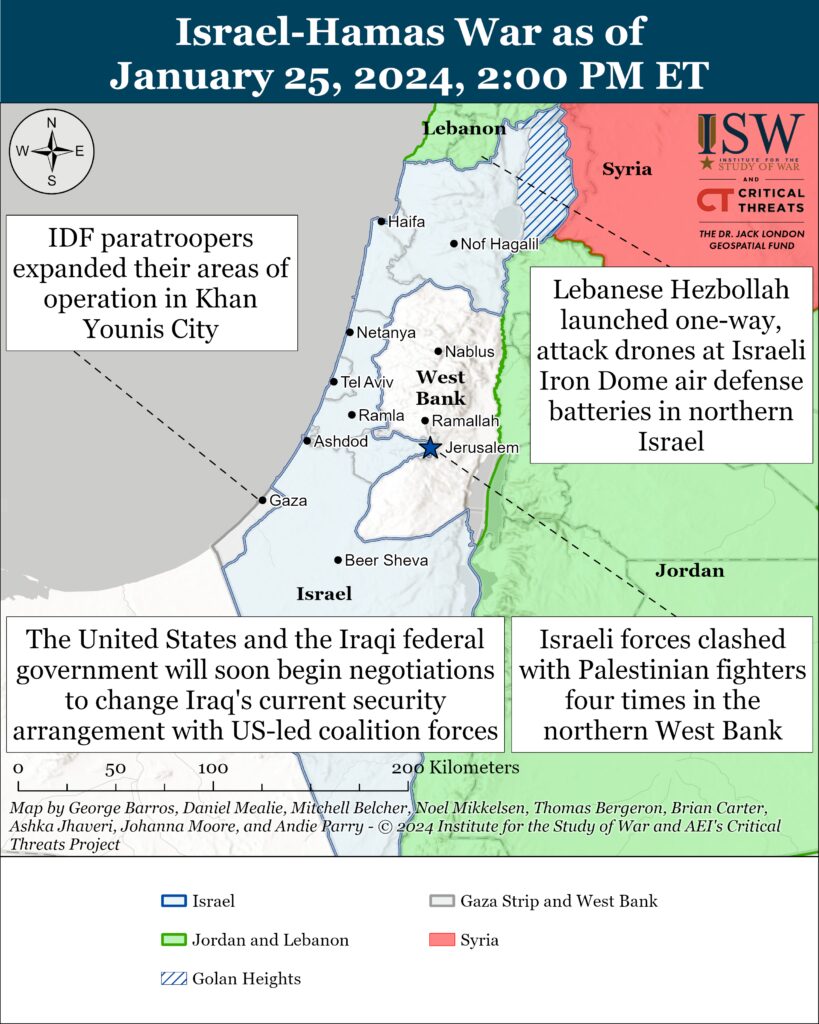
The United States and the Iraqi federal government will soon begin negotiations on Iraq’s current security arrangement with US-led coalition forces, which could involve US forces withdrawing from Iraq. US-led coalition forces have been deployed to Iraq at the invitation of the Iraqi federal government since 2014 to fight the Islamic State in Iraq and Syria (ISIS).[i] US Defense Secretary Lloyd Austin announced on January 25 that the US-Iraq Higher Military Commission (HMC), which is comprised of US and Iraqi federal government officials, will soon hold “working group meetings” to evaluate the status of the US-led Global Coalition’s mission to defeat ISIS.[ii] Unspecified sources told Western media that the United States dropped a condition requiring Iranian-backed Iraqi militias to stop attacking US forces in Iraq before negotiations start.[iii] Austin said that US defense professionals will advise the HMC on the “threat from ISIS, operational and environmental requirements, and the Iraqi Security Forces’ (ISF) capability levels.”[iv] Austin added that the HMC meetings will “enable the transition to an enduring bilateral security relationship” between the United States and Iraq.[v] This statement is consistent with previous statements from Mohammad Shia al Sudani administration officials that the Iraqi federal government seeks to establish “bilateral relationships” with the United States and International Coalition countries.[vi]
The Iraqi Foreign Affairs Ministry confirmed on January 25 the start of negotiations about the presence of US-led coalition forces in Iraq in the near future.[vii] The ministry announced that the HMC meetings aim to “initiate the gradual and deliberate reduction of [International Coalition] advisers on Iraqi soil” and “end the coalition’s military mission against ISIS.” The ministry additionally expressed support for establishing comprehensive relations with coalition countries.[viii]
US forces and military infrastructure in Iraq provide critical logistical support that enables the presence of US forces in Syria. A US military withdrawal from Iraq would therefore necessitate the withdrawal of US forces from Syria.[ix] CTP-ISW continues to assess that the United States and its partners in Syria have successfully contained but not defeated ISIS and that a US withdrawal from Syria would very likely cause a rapid ISIS resurgence in Syria within 12 to 24 months.[x] A resurgent ISIS would then be able to threaten Iraq. The ISF still faces significant deficiencies in fire support, intelligence, and logistics that will impede its ability to defeat ISIS alone.[xi]
Iranian-backed Iraqi actors praised the US and Iraqi decision to begin negotiations about the status of US-led coalition forces in Iraq. The Shia Coordination Framework—a loose coalition of Iranian-backed political parties—released a statement on January 25 lauding the Sudani administration’s efforts to “redraw” Iraq’s relationship with the US-led Global Coalition.[xii] This statement is consistent with CTP-ISW’s assessment that Iranian-backed Iraqi actors have used military and political pressure in recent months to expel US forces from Iraq. The framework expressed support for the “transition to comprehensive bilateral relations with the coalition countries in the political, economic, cultural, security and military fields,” although it is not clear whether the framework shares Sudani’s interpretation of bilateral relations. CTP-ISW previously assessed that Sudani is attempting to retain some US presence in Iraq and that his approach conflicts with Iranian-backed Iraqi actors’ maximalist demands to immediately remove all US forces from Iraq.
Iranian-backed militias and political factions in Iraq would likely frame a US departure from Iraq as a victory for Iran and its so-called “Axis of Resistance.” An Iraqi parliamentarian affiliated with the Iranian-backed Iraqi militia Kataib Hezbollah, Mustafa Sanad, claimed on January 25 that US-led coalition forces “will leave [Iraq] under the influence of weapons.”[xiii] Iranian-backed Iraqi militias have attacked US positions in Iraq and Syria over 150 times since the Israel-Hamas war began to impose a cost on the United States for supporting Israel and to erode willingness to remain militarily in the Middle East.[xiv] Sanad’s statement highlights Iranian and Axis of Resistance leaders’ theory that relatively low levels of militant pressure will gradually diminish the willingness of the US political establishment to sustain deployments in the Middle East.[xv]
Houthi Supreme Leader Abdulmalik al Houthi falsely claimed that Houthi attacks on maritime traffic in the Red Sea have not significantly impacted maritime trade. Abdulmalik made the statement in a speech on January 25 criticizing recent US strikes targeting Houthi military targets.[xvi] Major shipping companies have rerouted their operations away from the Red Sea in response to Houthi attacks, disrupting supply chains and driving higher inflation rates.[xvii] Maritime traffic through the Suez Canal decreased by 30 percent in early January 2024 compared to the previous year.[xviii] Reuters reported on January 11 that Houthi attacks caused a 40 percent decrease in US dollar revenues from the Suez Canal from 2023 to 2024.[xix] Approximately 10 to 12 percent of global trade passes through the Suez Canal, generating roughly eight billion dollars of revenue.[xx] Abdulmalik claimed that the Houthis have used 200 drones and 50 missiles thus far in their anti-shipping attack campaign, which, if true, demonstrates the relatively little the Houthis had to spend to disrupt a major corridor for international trade.
Abdulmalik separately reiterated the false Houthi narrative that the anti-shipping attacks have only targeted Israel-linked vessels and further claimed that the Houthis have allowed almost 5,000 non-Israel-linked vessels to freely operate in the Red Sea since the onset of their attack campaign.[xxi] The Houthis have repeatedly targeted merchant vessels with no obvious connections to Israel, as CTP-ISW has continually reported.[xxii]
Gaza Strip
Axis of Resistance campaign objectives:
Erode the will of the Israeli political establishment and public to launch and sustain a major ground operation into the Gaza Strip
Degrade IDF material and morale around the Gaza Strip.Several Palestinian militias attacked Israeli forces in the northern Gaza Strip on January 25. Palestinian Islamic Jihad (PIJ) fired rockets at Israeli infantry northwest of Beit Hanoun.[xxiii] The militia previously fired a rocket salvo from Beit Hanoun toward southern Israel on January 15.[xxiv] Separately, Hamas and the Palestinian Mujahideen Movement, which is a Palestinian faction aligned with Hamas and that has expressed close ties with Iran, fired rockets at a group of Israeli forces in a combined attack northwest of Gaza City.[xxv] The Popular Front for the Liberation of Palestine (PFLP), which is a secular Palestinian faction fighting with Hamas, mortared Israeli forces in eastern Jabalia.[xxvi] Hamas and other Palestinian fighters have contested Israeli raids in this area throughout January 2024. The Israel Defense Forces (IDF) 5th Brigade (assigned to the 143rd Division) killed an unspecified number of Palestinian fighters and located weapons in the northern Gaza Strip.[xxvii]
PIJ and the PFLP conducted a combined attack targeting an Israeli supply line in the Central Governorate of the Gaza Strip on January 25.[xxviii] The PIJ operation marks the third indirect fire attack that the group has claimed targeting Israeli supply lines in recent days.[xxix] The IDF Yiftach Brigade (assigned to the 99th Division) raided several buildings in the central Gaza Strip.[xxx] Israeli forces identified Palestinian fighters in a building in the area and directed a helicopter strike targeting it.[xxxi]
Palestinian fighters continued conducting a deliberate defense against Israeli clearing operations in western and southern Khan Younis on January 25. Hamas’ military wing fired rocket-propelled grenades (RPG) targeting two Israeli tanks west of Khan Younis City.[xxxii] PIJ’s military wing fired small arms and mortars and RPGs and detonated an explosively formed penetrator (EFP) targeting Israeli armor and infantry in western and southern Khan Younis.[xxxiii] The military wing of the Democratic Front for the Liberation of Palestine (DFLP), which is a leftist Palestinian militia aligned with Hamas in the war, clashed with the IDF in western Khan Younis.[xxxiv] The al Aqsa Martyrs’ Brigades—the self-proclaimed militant wing of Fatah—fired small arms and ”appropriate weapons” at the IDF in western Khan Younis City.[xxxv]
The IDF continued to conduct clearing operations in Khan Younis on January 25. The IDF 89th Commando Brigade (assigned to the 98th Division) conducted several raids in Khan Younis.[xxxvi] The IDF Egoz Unit fired an Iron Sting precision mortar and killed three fighters. The Egoz Unit also eliminated four fighters in clashes in a building in Khan Younis. The IDF said that the Egoz Unit adapted a method of sniper fire to target Palestinian fighters exiting tunnels. The Maglan Unit (assigned to the 98th Division) raided the military headquarters of a commander of PIJ’s information unit.[xxxvii] The Maglan Unit also raided a Hamas military headquarters and located military equipment and weapons. IDF paratroopers expanded raids and eliminated multiple fighters in the al Amal neighborhood of Khan Younis.[xxxviii] The paratroopers directed an airstrike on four fighters approaching IDF soldiers in the area. A Palestinian journalist published footage of what the journalist said was the IDF Givati Brigade (assigned to the 162nd Division) demolishing buildings in Khan Younis.[xxxix]
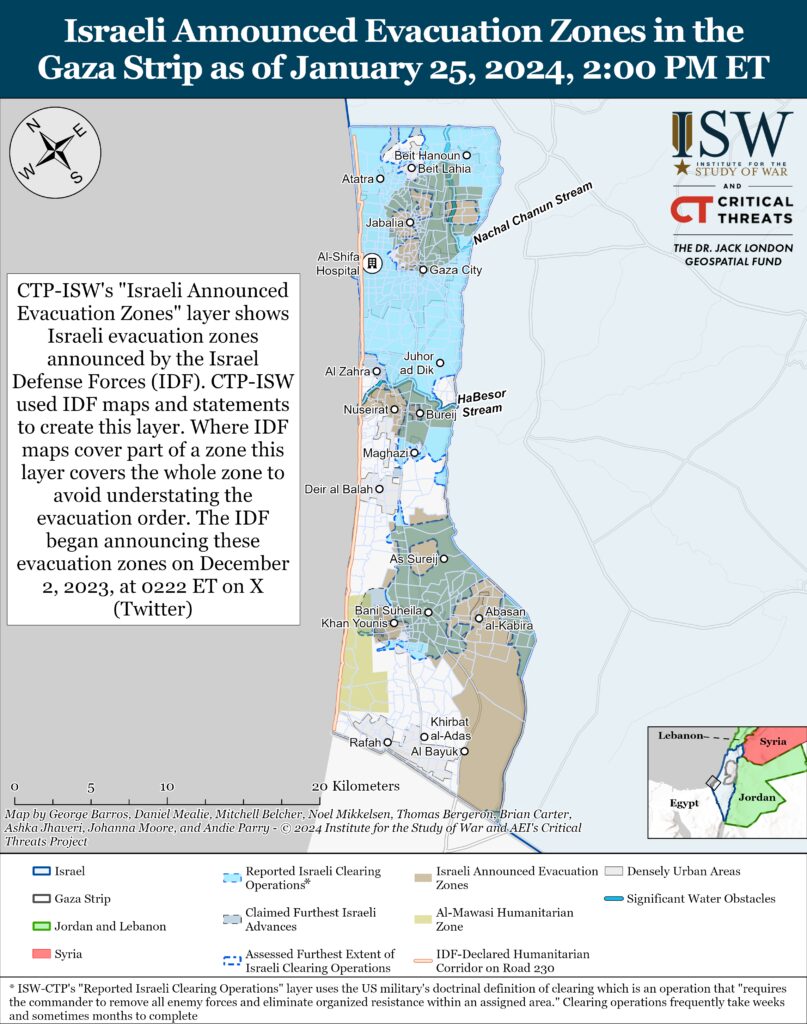
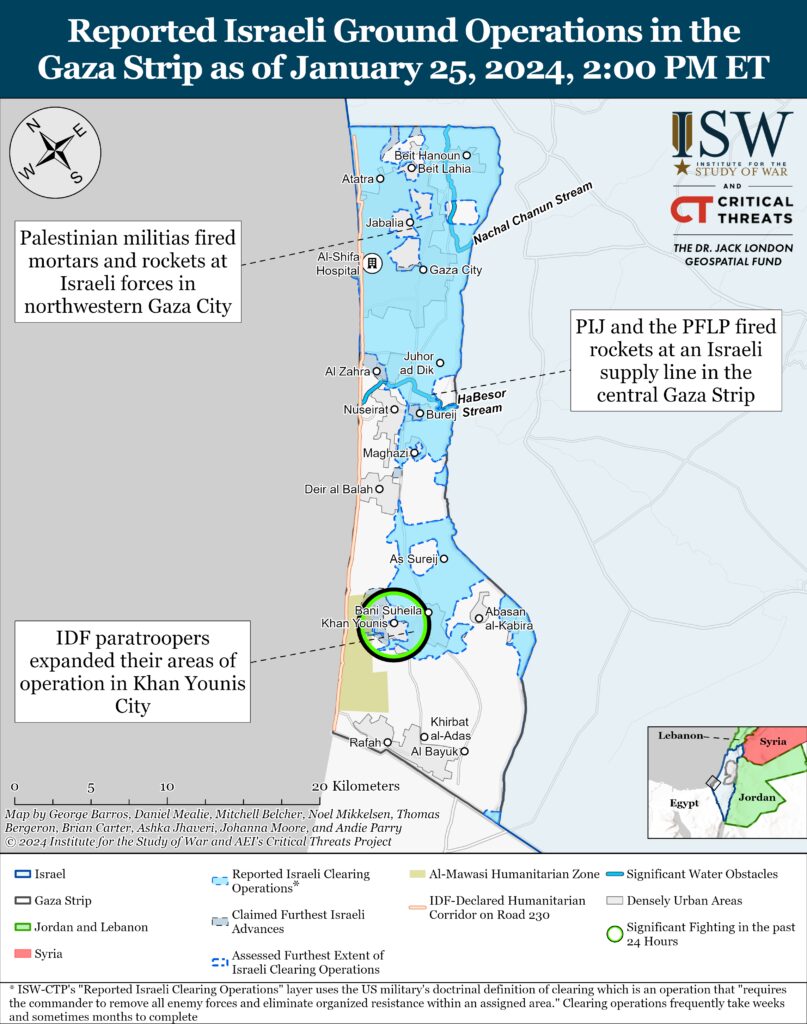
US Central Intelligence Agency Director Bill Burns will meet with the Qatari prime minister and the Egyptian and Israeli intelligence chiefs in the coming days to broker a deal for the release of hostages and a pause in fighting in the Gaza Strip.[xl] An unspecified senior Israeli official told Axios that Burns’ meeting is crucial to reaching a breakthrough in talks on a new deal that would include a two-month pause in fighting in exchange for Hamas releasing all Israeli hostages in the Gaza Strip.[xli] Another senior Israeli official said that Hamas must recognize that Israel will not agree to ending the war or releasing Hamas’ desired number of Palestinian prisoners as part of the deal.[xlii] The United States, Egypt, and Qatar have in recent days pushed a new diplomatic effort to end the Israel-Hamas war.[xliii]
Israel proposed a two-month pause in fighting on January 21 in exchange for Hamas releasing the remaining hostages in the Gaza Strip.[xliv] Hamas reportedly rejected the Israeli proposal, likely because it did not include measures to end Israel’s plan to destroy Hamas. Egypt also rejected the proposal because it did not include an agreement to end the war, according to the Wall Street Journal.[xlv]
The military wing of the DFLP fired mortars targeting IDF vehicles at the Karm Abu Salem site in southern Israel.[xlvi]
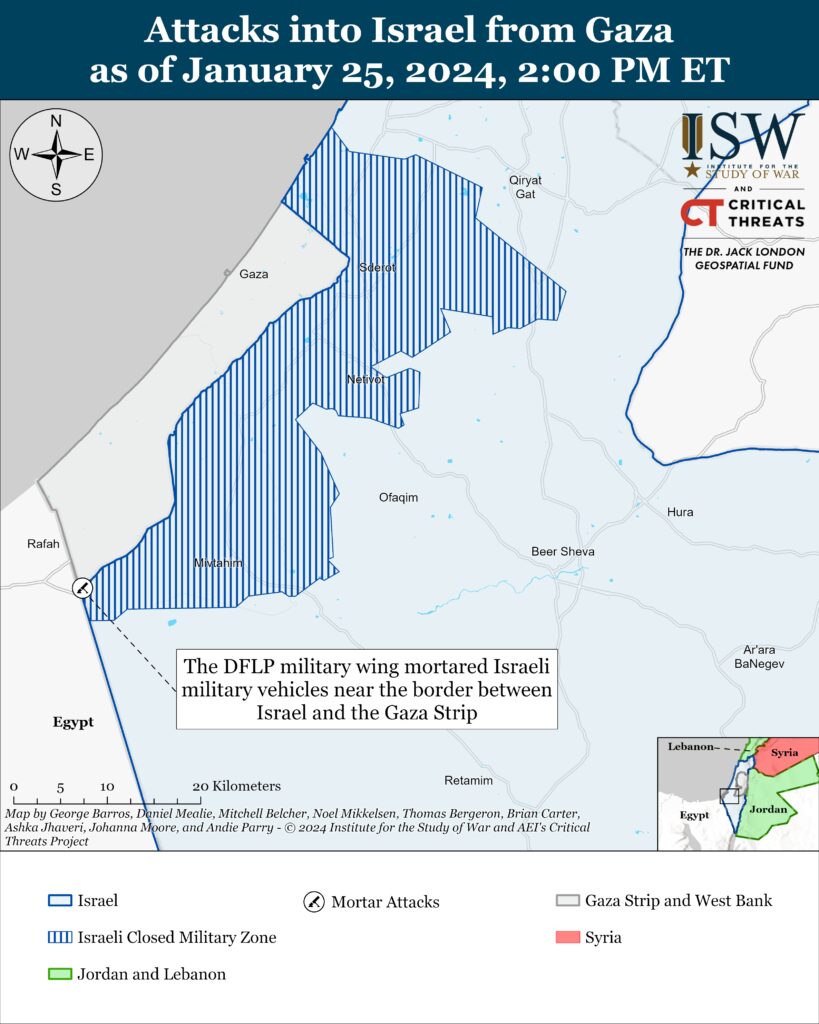
Recorded reports of attacks; CTP-ISW cannot independently verify impact.
West Bank
Axis of Resistance campaign objectives:
Draw IDF assets and resources toward the West Bank and fix them thereIsraeli forces clashed with Palestinian fighter four times in the northern West Bank on January 25. Israeli forces conducted operations around Jenin governorate and identified road-buried improvised explosive devices (IEDs) in Jenin refugee camp.[xlvii] PIJ fighters detonated an IED targeting an Israeli armored vehicle in the camp.[xlviii] PIJ claimed it damaged the vehicle and wounded Israeli soldiers inside. The al Aqsa Martyrs’ Brigades, the self-proclaimed militant wing of Fatah, claimed it targeted Israeli forces with explosives and small arms fire in Jenin City.[xlix] The al Aqsa Martyrs’ Brigades also posted footage showing Palestinian fighters targeting Israeli forces at the Tayasir checkpoint in Tubas.[l] Israeli forces shot and killed a Palestinian fighter in Bir al Basha, who fired on Israeli forces.[li] Hamas later claimed that the Palestinian fighter was a Hamas member.[lii]
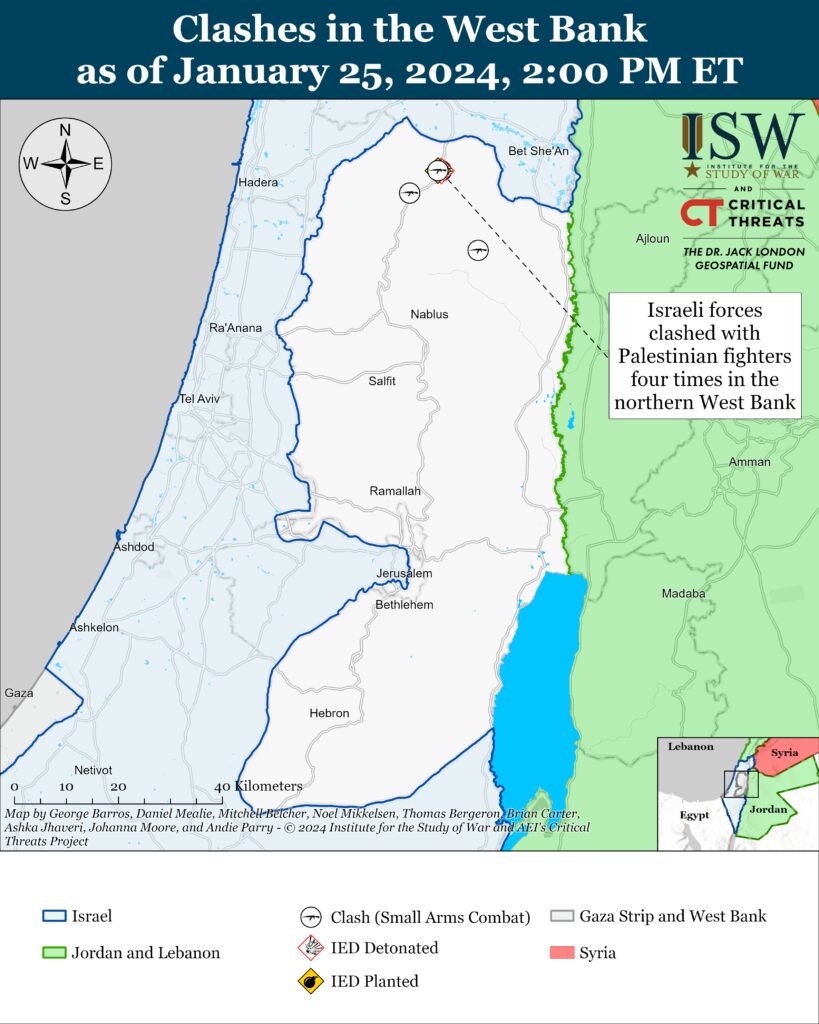
This map is not an exhaustive depiction of clashes and demonstrations in the West Bank.
Southern Lebanon and Golan Heights
Axis of Resistance campaign objectives:
Draw IDF assets and resources toward northern Israel and fix them there
Set conditions for successive campaigns into northern IsraelIranian-backed militias, including Lebanese Hezbollah, conducted four attacks from southern Lebanon into northern Israel on January 25.[liii] Hezbollah launched two one-way attack drones at Israeli Iron Dome air defense batteries in Kfar Blum.[liv] Hezbollah has only claimed one other attack on Iron Dome batteries during the Israel-Hamas war.[lv] Hezbollah drone attacks into Israel are relatively rare, as the group more commonly uses anti-tank munitions in its regular attacks on Israeli targets.
The IDF Air Force struck a Hezbollah military runway 10 miles from the Israel-Lebanon border shortly after Hezbollah conducted the drone attack into Israel.[lvi] The IDF said that Hezbollah’s air unit uses the runway and its facilities to conduct attacks into Israel.[lvii] Israeli Defense Minister Yoav Gallant released Israeli intelligence in September 2023 that demonstrated the IRGC’s role in constructing the airstrip.[lviii]
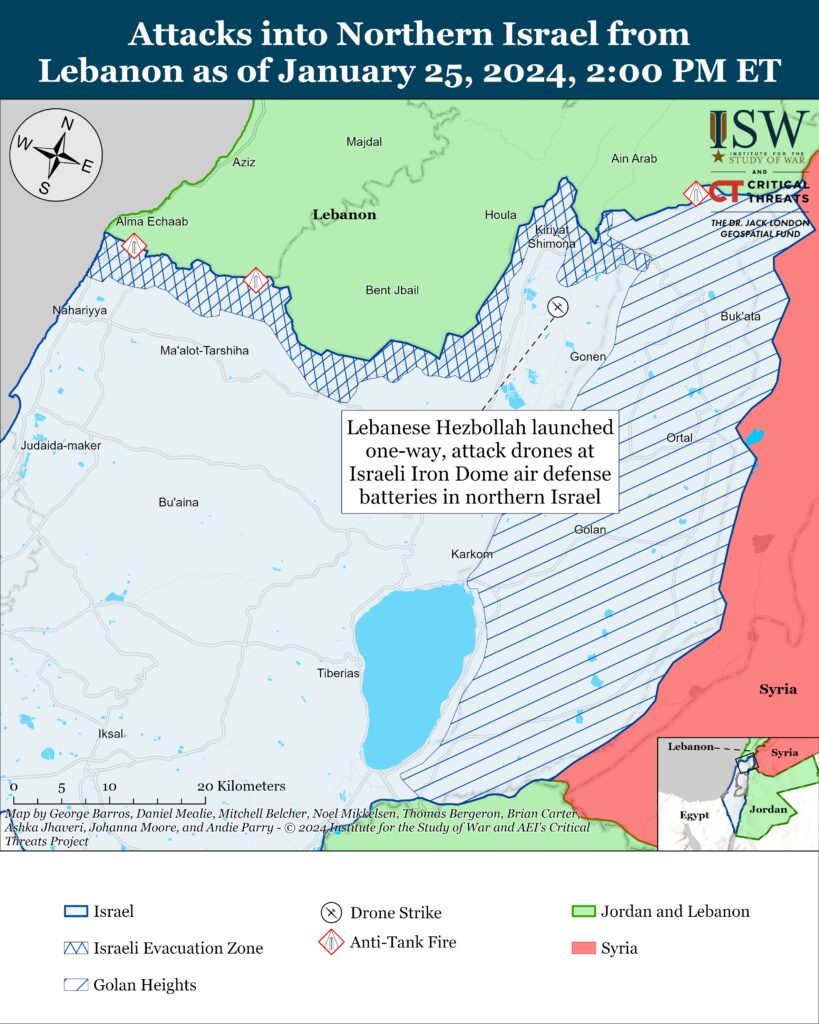
Recorded reports of attacks; CTP-ISW cannot independently verify impact.
Iran and Axis of Resistance
Axis of Resistance campaign objectives:
Demonstrate the capability and willingness of Iran and the Axis of Resistance to escalate against the United States and Israel on multiple fronts
Set conditions to fight a regional war on multiple frontsIranian-backed Iraqi militia Kataib Hezbollah called for expanding the scope of militia attacks to include additional US interests in Iraq and the Middle East in response to the January 23 US airstrikes targeting three Kataib Hezbollah facilities.[lix] The United States conducted the airstrikes in response to a Kataib Hezbollah ballistic missile and rocket attack targeting Ain al Asad airbase that left four US personnel with traumatic brain injuries.[lx] Kataib Hezbollah is part of the Islamic Resistance in Iraq—a coalition of Iranian-backed Iraqi militias that have conducted over 150 attacks targeting US forces in Iraq and Syria since the Israel-Hamas war began.[lxi]
The Islamic Resistance in Iraq claimed responsibility for four attacks targeting US positions in Iraq and Syria on January 24 and 25.[lxii] The Islamic Resistance in Iraq claimed attacks targeting US forces at US Conoco Mission Support Site in northeastern Syria, Erbil International Airport in Erbil Province, Iraq, and Ain al Asad airbase in Anbar Province, Iraq, on January 24.[lxiii] The group did not specify what munitions it used in these attacks. The Islamic Resistance in Iraq separately claimed a drone attack targeting US forces at Erbil International Airport on January 25.[lxiv]
The Islamic Resistance in Iraq also claimed that it conducted a drone attack targeting the Israeli port of Ashdod, south of Tel Aviv, on January 25.[lxv] The group targeted Ashdod for the first time on January 23.[lxvi]
The United States and United Kingdom sanctioned four Houthi officials on January 25.[lxvii] The US Treasury Department’s Office of Foreign Assets Control (OFAC) stated that the US and UK designated these individuals for supporting the recent Houthi attacks targeting commercial vessels in the Red Sea. The US and UK designated the following individuals:
Houthi “Defense Minister” Mohamed al Atifi
Houthi “maritime forces commander” Muhammad Fadl Abd al Nabi
Houthi “coastal defense forces chief” and “naval college director” Muhammad Ali al Qadiri
Houthi “procurement director” Mohammad Ahmad al TalibiOFAC noted that Talibi coordinates with Iran’s Islamic Revolutionary Guards Corps (IRGC) to smuggle Iranian-provided drones, missiles, and other weapons components into Yemen.[lxviii] US outlet Semafor reported on January 15 that the IRGC Quds Force has overseen the transfer to Yemen of the drones and missiles that the Houthis have used in their attacks targeting maritime shipping in the Red Sea.[lxix] Semafor also reported that the IRGC Quds Force placed drone and missile operators and trainers as well as intelligence personnel on the ground in Houthi-controlled Yemen to direct Houthi drone and missile attacks and provide tactical intelligence support to the Houthis.[lxx] UK outlet Daily Telegraph reported on January 10 that the IRGC trained a group of 200 Houthis at the Khamenei Academy of Naval Sciences and Technology in northern Iran prior to the Houthi attacks.[lxxi]
The Wall Street Journal (WSJ) reported that the United States secretly warned Iran that the Islamic State was preparing to conduct the January 3 terrorist attack in Kerman.[lxxii] WSJ reported that the United States passed actionable intelligence to Tehran prior to the attack. Anonymous US officials said that the information provided regarding the location and time were specific enough that the regime could have thwarted the attack. The Islamic State killed at least 94 people in the Kerman attack.[lxxiii]
Iranian President Ebrahim Raisi and Turkish President Recep Tayyip Erdogan issued a joint statement on the Israel-Hamas war and Iranian-Turkish relations after Raisi’s visit to Ankara on January 25.[lxxiv] The joint statement condemned Israel’s actions in the Gaza Strip. The statement noted the need for “decisive measures” to stop Israel’s actions in the Gaza Strip. Raisi and Erdogan expressed their desire for unspecified “competent courts“ to try Israeli military and political leaders. The two leaders also expressed Iran’s and Turkey’s willingness to jointly combat terrorism.
Iranian President Ebrahim Raisi discussed the Israel-Hamas war with Nigerien Prime Minister Ali Lamine Zeine on January 25.[lxxv] Raisi condemned the humanitarian disaster in the Gaza Strip.
Iranian Foreign Affairs Minister Hossein Amir Abdollahian threatened in a press conference on January 25 that any country normalizing ties with Israel will pay a “heavy price” on January 25.[lxxvi] Abdollahian was responding to a reporter asking whether Iran supported the normalization of relations between Israel and Saudi Arabia. Iran and Saudi Arabia resumed diplomatic relations in March 2023.[lxxvii]
The Iranian deputy foreign affairs minister discussed the Israel-Hamas war with the Norwegian deputy foreign affairs minister on January 24.[lxxviii] The Iranian deputy foreign affairs minister condemned the war and called for an immediate ceasefire. Norway’s special representative for Yemen and the Middle East also attended the meeting.
The Iranian Foreign Affairs Ministry senior adviser discussed the Israel-Hamas war in separate meetings with senior Turkish and UN officials during the latest round of Astana talks in Kazakhstan on January 25.[lxxix] The Iranian official criticized the United States over its support for Israel. He said that all regional countries have been negatively impacted by the Israel-Hamas war. Representatives from Iran, Russia, and Turkey released a joint statement at the end of the talks on January 25, condemning Israeli airstrikes in Syria.[lxxx] Israeli airstrikes in Syria on January 20 killed at least five IRGC officers in Syria.[lxxxi]
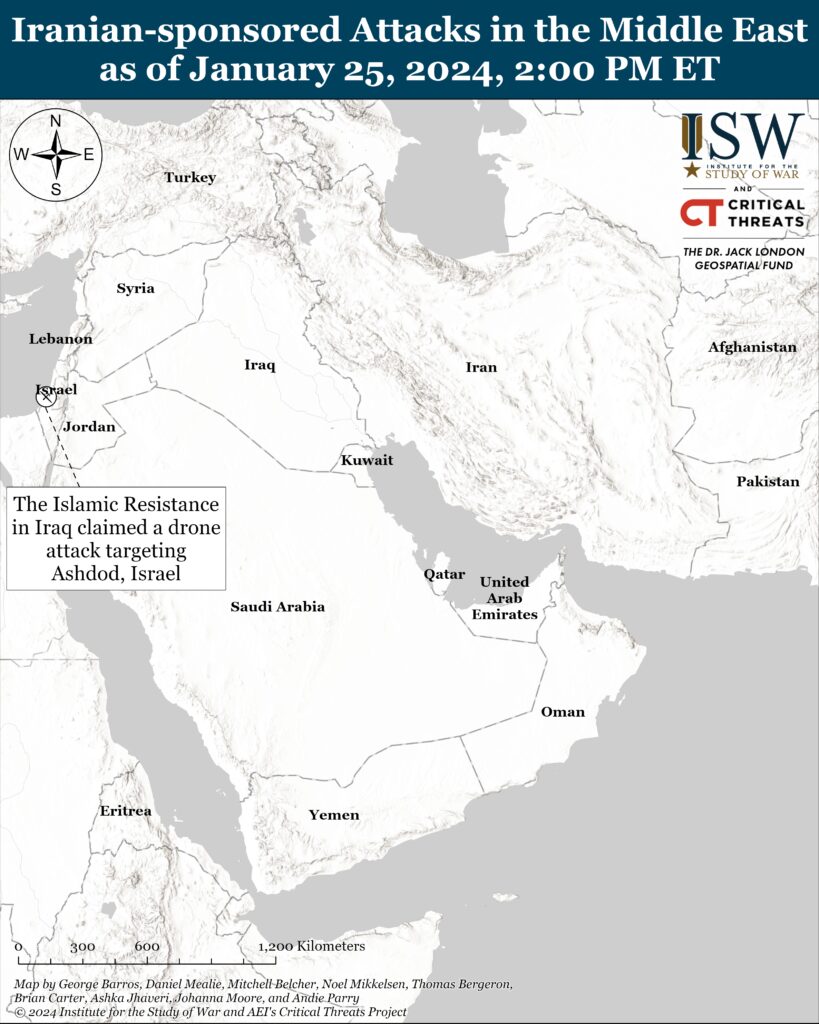
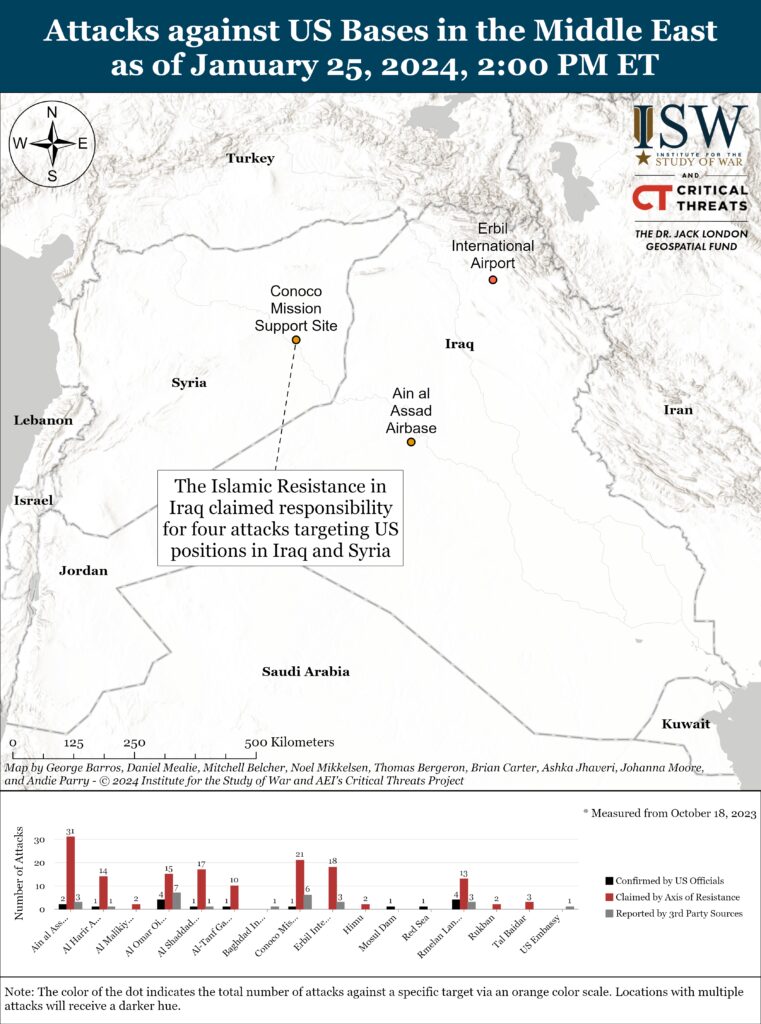
 Eurasia Press & News
Eurasia Press & News
